Other Parts Discussed in Thread: LM5156
Tool/software:
Hi team,
I am trying to understand the frequency response of a sepic designed using lm5156 with two methods:
method1: Using the quickstart calculator excel tool for LM5156, it gives a bode plot with option for varying input voltage but not with different load.
- I wanted to understand how reliable is this graph and also how to get it for different loads.
- The initial phase seen in that plot always starts from +90degrees at DC, which does not look correct or I might be missing something.
method2: Using the average pspice model of lm5156. The simulation setup downloaded from TI website seems to be set for a boost converter. I am not able to understand where to put the coupled inductors and coupling capacitor to set it up for a SEPIC circuit. It looks like the model has the output diode modelled inside it so it is not clear how it can be modified for sepic.
I would appreciate if you could help understand both the above. Maybe some application note on using this if available?
Best regards,
Abhishek



